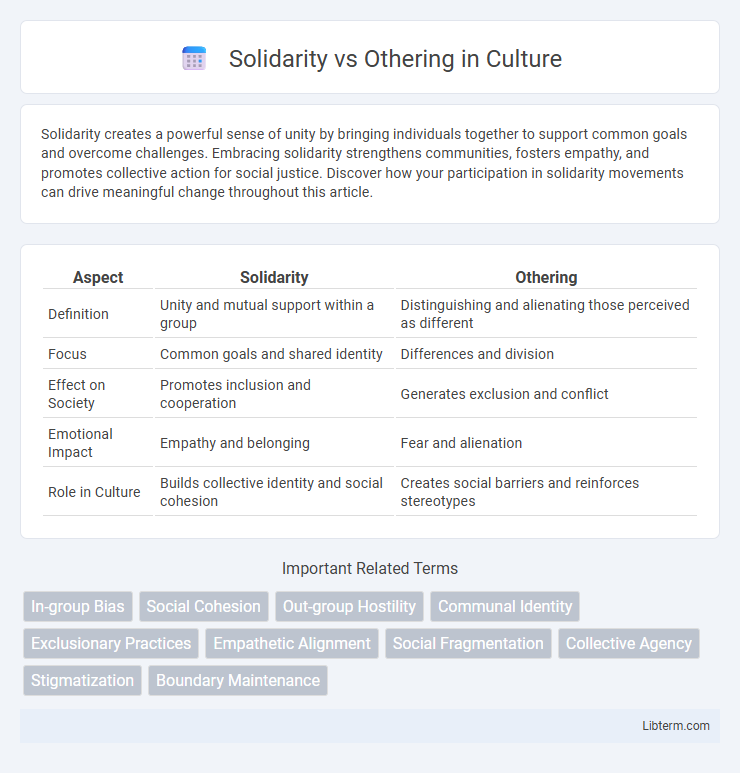Solidarity creates a powerful sense of unity by bringing individuals together to support common goals and overcome challenges. Embracing solidarity strengthens communities, fosters empathy, and promotes collective action for social justice. Discover how your participation in solidarity movements can drive meaningful change throughout this article.
Table of Comparison
| Aspect | Solidarity | Othering |
|---|---|---|
| Definition | Unity and mutual support within a group | Distinguishing and alienating those perceived as different |
| Focus | Common goals and shared identity | Differences and division |
| Effect on Society | Promotes inclusion and cooperation | Generates exclusion and conflict |
| Emotional Impact | Empathy and belonging | Fear and alienation |
| Role in Culture | Builds collective identity and social cohesion | Creates social barriers and reinforces stereotypes |
Understanding Solidarity: Definition and Importance
Solidarity is the unity and mutual support within a group, crucial for fostering social cohesion and collective action. It involves recognizing shared interests and common goals, promoting empathy and inclusivity across diverse communities. Understanding solidarity enhances societal resilience by bridging divides and countering exclusionary practices like othering.
The Concept of Othering: Origins and Impacts
The concept of othering originates from social and psychological processes that create divisions by categorizing individuals or groups as fundamentally different, often leading to exclusion and marginalization. Othering reinforces in-group and out-group dynamics, shaping power relations and social inequalities across cultures and history. Its impacts include diminished social cohesion, increased prejudice, and barriers to empathy and mutual understanding, undermining collective efforts toward solidarity and inclusive societies.
Historical Contexts: Solidarity vs Othering
Historical contexts reveal how solidarity emerged as a critical response to exclusion and oppression, fostering collective identity among marginalized groups. Instances such as the labor movements of the 19th century and anti-colonial struggles demonstrate solidarity's power in uniting diverse populations against systemic inequality. Conversely, othering has often been institutionalized through segregation, discriminatory laws, and propaganda that deepen social divides and justify exclusion.
Psychological Mechanisms Behind Othering
Othering stems from cognitive processes such as categorization and social identity theory, where individuals distinguish in-groups from out-groups to enhance self-esteem and social cohesion. Psychological defense mechanisms like projection and scapegoating further fuel exclusion, as fears and insecurities are displaced onto marginalized groups. These processes undermine solidarity by promoting division through stereotyping, dehumanization, and reinforcing perceived differences.
Building Inclusive Communities Through Solidarity
Building inclusive communities through solidarity fosters empathy, mutual respect, and shared goals among diverse groups, reducing social divides and promoting cohesion. Solidarity emphasizes collective action and support, contrasting with othering, which isolates individuals based on perceived differences such as race, ethnicity, or socioeconomic status. By prioritizing inclusivity, communities can create environments where all members feel valued, empowered, and connected.
The Consequences of Othering in Modern Society
Othering in modern society fosters division by marginalizing groups based on race, ethnicity, gender, or belief, which intensifies social inequality and fuels discrimination. The psychological impact includes increased feelings of alienation and reduced opportunities for affected individuals, leading to widespread social fragmentation. Persistent othering undermines collective progress by eroding trust and cooperation necessary for inclusive community development and social cohesion.
Case Studies: Solidarity in Action
Case studies of solidarity in action demonstrate how communities unite to overcome social inequalities and promote inclusivity, such as mutual aid networks during crises or grassroots environmental movements advocating for justice. These examples highlight the active resistance to othering by fostering empathy, shared identity, and collective empowerment among marginalized groups. The effectiveness of solidarity is measured by increased social cohesion, policy changes, and resilience against divisive forces perpetuating exclusion.
Strategies to Counteract Othering
Strategies to counteract othering include promoting inclusive language that recognizes shared humanity and emphasizes common values across diverse groups. Implementing community-building initiatives fosters empathy and understanding by encouraging dialogue and collaboration among individuals from different backgrounds. Educational programs that highlight the consequences of exclusion and the benefits of solidarity strengthen social cohesion and reduce prejudice.
The Role of Media in Shaping Solidarity and Othering
Media plays a crucial role in shaping solidarity and othering by framing social narratives that influence public perception and group identity. Through selective representation and language, media can either promote inclusivity by highlighting common goals and shared experiences or reinforce divisions by emphasizing differences and perpetuating stereotypes. The impact of media narratives on social cohesion is evident in how marginalized groups are portrayed, affecting both societal attitudes and policy responses.
Moving Forward: Fostering a Culture of Solidarity
Moving forward, fostering a culture of solidarity requires intentional policies that promote inclusivity and mutual respect across diverse communities. Emphasizing shared goals and interdependence can counteract patterns of othering by highlighting common humanity and collective well-being. Educational programs and community initiatives that prioritize empathy and collaboration strengthen social cohesion and resilience in increasingly multicultural societies.
Solidarity Infographic

 libterm.com
libterm.com